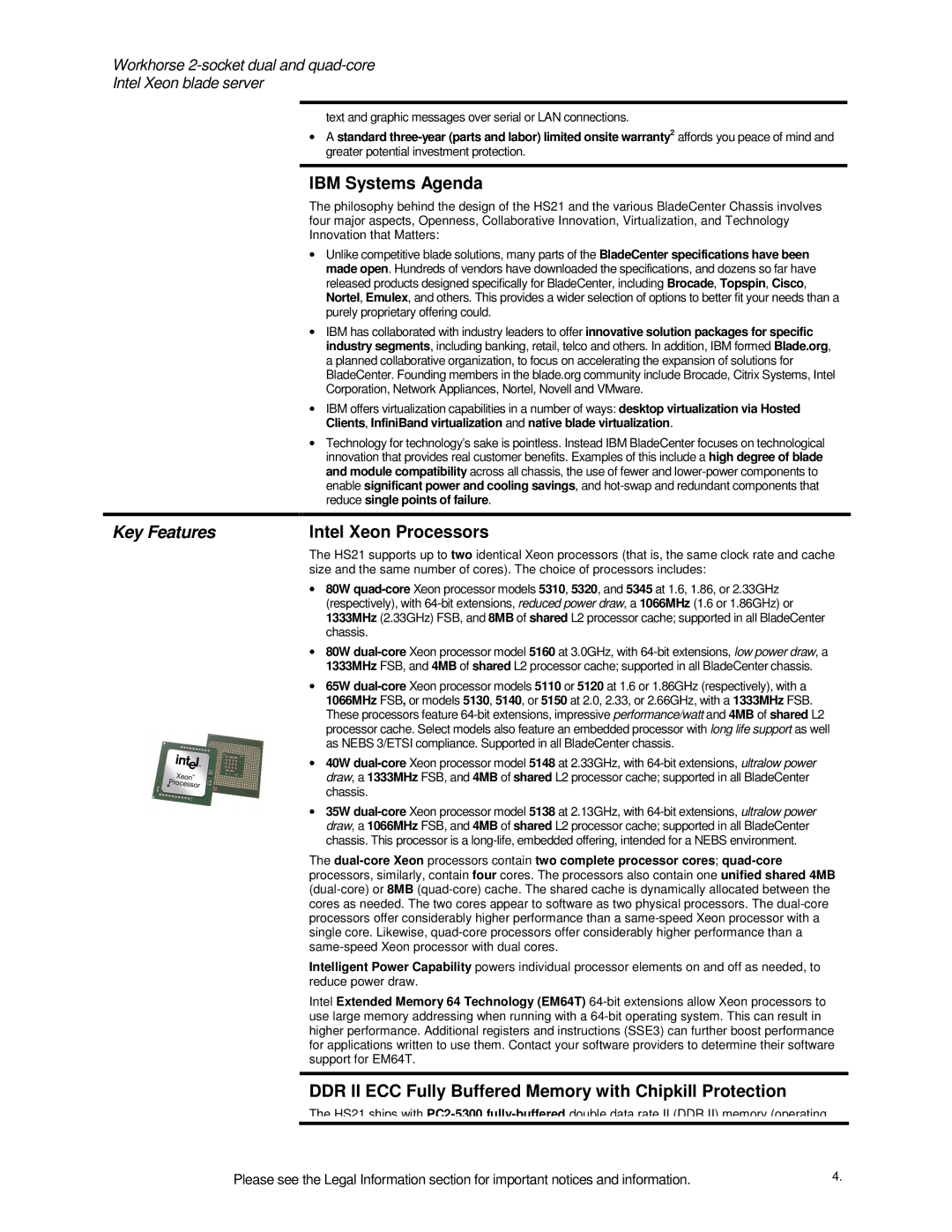
Workhorse
Intel Xeon blade server
text and graphic messages over serial or LAN connections.
• A standard
greater potential investment protection.
IBM Systems Agenda
The philosophy behind the design of the HS21 and the various BladeCenter Chassis involves four major aspects, Openness, Collaborative Innovation, Virtualization, and Technology Innovation that Matters:
• Unlike competitive blade solutions, many parts of the BladeCenter specifications have been made open. Hundreds of vendors have downloaded the specifications, and dozens so far have released products designed specifically for BladeCenter, including Brocade, Topspin, Cisco, Nortel, Emulex, and others. This provides a wider selection of options to better fit your needs than a purely proprietary offering could.
• IBM has collaborated with industry leaders to offer innovative solution packages for specific industry segments, including banking, retail, telco and others. In addition, IBM formed Blade.org, a planned collaborative organization, to focus on accelerating the expansion of solutions for BladeCenter. Founding members in the blade.org community include Brocade, Citrix Systems, Intel Corporation, Network Appliances, Nortel, Novell and VMware.
• IBM offers virtualization capabilities in a number of ways: desktop virtualization via Hosted
Clients, InfiniBand virtualization and native blade virtualization.
| • Technology for technology’s sake is pointless. Instead IBM BladeCenter focuses on technological | |
| innovation that provides real customer benefits. Examples of this include a high degree of blade | |
| and module compatibility across all chassis, the use of fewer and | |
| enable significant power and cooling savings, and | |
| reduce single points of failure. | |
|
|
|
Key Features | Intel Xeon Processors | |
| The HS21 supports up to two identical Xeon processors (that is, the same clock rate and cache | |
| size and the same number of cores). The choice of processors includes: | |
| • 80W | |
| (respectively), with | |
| 1333MHz (2.33GHz) FSB, and 8MB of shared L2 processor cache; supported in all BladeCenter | |
| chassis. | |
| • 80W | |
| 1333MHz FSB, and 4MB of shared L2 processor cache; supported in all BladeCenter chassis. | |
| • 65W | |
| 1066MHz FSB, or models 5130, 5140, or 5150 at 2.0, 2.33, or 2.66GHz, with a 1333MHz FSB. | |
| These processors feature | |
| processor cache. Select models also feature an embedded processor with long life support as well | |
| as NEBS 3/ETSI compliance. Supported in all BladeCenter chassis. | |
| • 40W | |
| draw, a 1333MHz FSB, and 4MB of shared L2 processor cache; supported in all BladeCenter | |
| chassis. | |
| • 35W | |
| draw, a 1066MHz FSB, and 4MB of shared L2 processor cache; supported in all BladeCenter | |
| chassis. This processor is a | |
| The | |
| processors, similarly, contain four cores. The processors also contain one unified shared 4MB | |
| ||
| cores as needed. The two cores appear to software as two physical processors. The | |
| processors offer considerably higher performance than a | |
| single core. Likewise, | |
| ||
| Intelligent Power Capability powers individual processor elements on and off as needed, to | |
| reduce power draw. | |
| Intel Extended Memory 64 Technology (EM64T) | |
| use large memory addressing when running with a | |
| higher performance. Additional registers and instructions (SSE3) can further boost performance | |
| for applications written to use them. Contact your software providers to determine their software | |
| support for EM64T. | |
|
|
|
| DDR II ECC Fully Buffered Memory with Chipkill Protection | |
| The HS21 ships with |
|
Please see the Legal Information section for important notices and information. | 4. |
